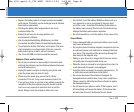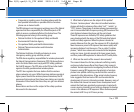
88 The V
Safety
8. Use your wireless phone to call for help. Your wireless
phone is one of the greatest tools you can own to protect
yourself and your family in dangerous situations -- with your
phone at your side, help is only three numbers away. Dial
911 or other local emergency number in the case of fire,
traffic accident, road hazard or medical emergency.
Remember, it is a free call on your wireless phone!
9. Use your wireless phone to help others in emergencies.
Your wireless phone provides you a perfect opportunity to
be a “Good Samaritan” in your community. If you see an
auto accident, crime in progress or other serious
emergency where lives are in danger, call 911 or other local
emergency number, as you would want others to do for you.
10. Call roadside assistance or a special wireless non-
emergency assistance number when necessary. Certain
situations you encounter while driving may require attention,
but are not urgent enough to merit a call for emergency
services. But you can still use your wireless phone to lend a
hand. If you see a broken-down vehicle posing no serious
hazard, a broken traffic signal, a minor traffic accident
where no one appears injured or a vehicle you know to be
stolen, call roadside assistance or other special non-
emergency wireless number.
For more information, please call to 888-901-SAFE, or visit our
website www.wow-com.com
Consumer Information on SAR
(Specific Absorption Rate)
This Model Phone Meets the Government’s Requirements for
Exposure to Radio Waves. Your wireless phone is a radio
transmitter and receiver. It is designed and manufactured not to
exceed the emission limits for exposure to Radio Frequency (RF)
energy set by the Federal Communications Commission of the
U.S. Government. These limits are part of comprehensive
guidelines and establish permitted levels of RF energy for the
general population. The guidelines are based on standards that
were developed by independent scientific organizations through
periodic and thorough evaluation of scientific studies. The
standards include a substantial safety margin designed to
assure the safety of all persons, regardless of age and health.
The exposure standard for wireless mobile phones employs a
unit of measurement known as the Specific Absorption Rate, or
SAR. The SAR limit set by the FCC is 1.6 W/kg. Tests for SAR are
conducted using standard operating positions specified by the
FCC with the phone transmitting at its highest certified power
level in all tested frequency bands. Although SAR is determined
at the highest certified power level, the actual SAR level of the
phone while operating can be well below the maximum value.
Because the phone is designed to operate at multiple power
levels to use only the power required to reach the network, in
general, the closer you are to a wireless base station antenna,
The V(E).qxd(1.2)_TTY MODE 2005.11.25 3:53 AM Page 88


















